The Return on Prevention: Evaluating Costs and Benefits of Workplace Safety Investments| ISSA Research Report-Pdf
| University | Atlantic Technological University Sligo - ATU Sligo |
| Subject | Occupational Safety and Health (OSH) Economics |
The return on prevention:
Calculating the costs and benefits of investments
in occupational safety and health in companies
International Social Security Association (ISSA)
German Social Accident Insurance (DGUV)
German Social Accident Insurance Institution for
the Energy, Textile, Electrical and Media Products Sectors (BG ETEM)
I. Introduction and objective
Occupational safety and health (OSH) programmes benefit employees by preventing work accidents and occupational illnesses. Although essential to the social security of workers, even the best compensation and rehabilitation programmes cannot make up for the loss in quality of life that results from a work-related accident or illness. And over the long term, such programmes have to be financially sustainable. It is only on the strength of effective workplace prevention strategies – geared to reduce the frequency and severity of insured workplace risk events – that potential losses in quality of life can be minimized and the financial sustainability of workers’ compensation and rehabilitation programmes be ensured.
An important question for companies is whether adopting a workplace prevention strategy is beneficial also at a microeconomic level. In this regard, in analysing the economic benefits of prevention measures, a distinction has to be made among the different types of effects of prevention measures: direct (i.e. prevention of accidents at work); indirect (i.e. improvement of public image); short-term (i.e. operating expenses for prevention measures); and long-term (i.e. sustainability of the benefits of prevention measures).
In 2010, the International Social Security Association (ISSA), the German Social Accident Insurance (DGUV), and the German Social Accident Insurance Institution for the Energy, Textile, Electrical and Media Products Sectors (BG ETEM) initiated an international study on “Calculating the international return on prevention for companies: Costs and benefits of investments in occupational safety and health”.
The international study looked at the question of how occupational safety and health is beneficial to companies. Answering this core question required that conceptual consideration was given to the idea of prevention accounting. It also required the collection of qualitative and quantitative data regarding the success of prevention. This report summarizes the initial results of the study.
Are You Searching Answer of this Question? Request Ireland Writers to Write a plagiarism Free Copy for You.
II. Concept and method
The goal of prevention accounting is to calculate the microeconomic effects of occupational safety and health in terms of qualitative and quantitative metrics. The aim is to develop a cost-benefit analysis. An ordinal scale is suitable for qualitative observations. The monetary success of prevention can be expressed as the difference between the (monetary) benefits of prevention and the costs of prevention. The key performance indicator “Return on Prevention” (ROP) is an abstract representation of the potential economic success of occupational safety and health.
Prevention accounting is an economic model based on several assumptions, similar to social and ecological accounting. For example, prevention in the workplace is looked at as a whole, without considering 4 the individual measures. Similarly, the effects of social and technical improvements as well as the built-in costs of safety associated with purchasing equipment are not taken into consideration.
The microeconomic effects of workplace prevention were obtained using standardized interviews. The interviews were conducted with experts (e.g. company owners, controllers, safety officers, works council members) in the selected companies. Where possible, the interviews were conducted in groups. Interviewees were asked to assess the costs and benefits of occupational safety and health based on their experience. Therefore, the companies involved in the interviews needed to have experience with workplace prevention.
This approach carries risks. On the one hand, there is the risk that the selective sampling of companies already involved in prevention might result in their offering an above-average positive rating. On the other hand, companies with only minor involvement in prevention may not be in a position to make reliable assessments regarding the benefits of prevention. Specifically, because the potential benefits of prevention to these companies remain largely unrealized, their assessments might offer an even higher above-average rating.
Therefore, the results should not be over-interpreted on methodological and statistical grounds, as they
are only assessments and estimates. Nevertheless, the findings are of value because those interviewed
were experts within their company and the empirical studies were based on interviews representing an
ambitious survey methodology.
The analysis of the data was carried out descriptively to create a consolidated prevention balance sheet for the participating companies and inductively to identify significant correlations. The participating countries were recommended to interview one company per one million employees, with a minimum of ten and a maximum of 40 companies surveyed. Interviews were conducted from mid-2010 to early 2011. German data was collected in 2007 and 2008 as part of the project “Prevention balance sheets from a theoretical and empirical point of view” (Bräunig / Mehnert, 2008). As the interview questions from this earlier project were the basis for the current project, it was possible to recode the German data. In total, 300 companies from 15 countries were involved in the interviews.
III. Selected results
The following results are based on the assessments offered by the interviewees. The descriptive analysis
represents average considerations. The results are not representative for individual companies, but
illustrate abstract statistical considerations.
Figure 1. Impact of occupational safety and health within selected areas
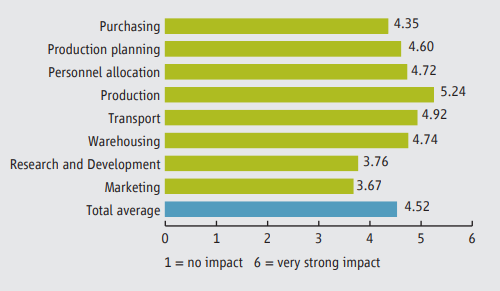
Given the positive selection of companies, it is not surprising that, overall, the effects of occupational safety and health were given a positive rating. Therefore, what is more significant is the difference in the ratings. Prevention had a particularly strong impact in the traditional prevention areas of production, transport and warehousing (Figure 1).
The direct effects of prevention also dominated hazard reduction, increased awareness of hazards and reductions in dangerous behaviour and accidents. The most significant indirect effects were improvements in company image and company culture (Figure 2).
Figure 2. Effects of occupational safety and health within the company
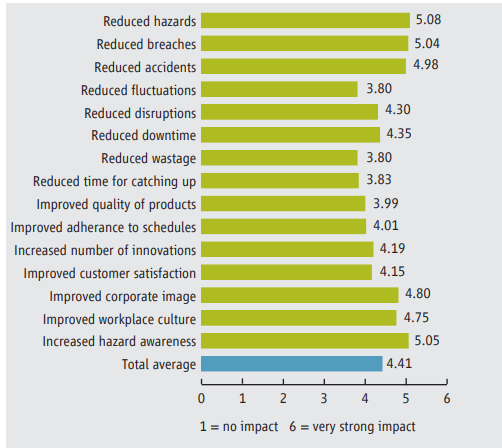
Half of the interviewed companies expected that additional investments in occupational safety and
health would decrease company costs over the long term (Figure 3).
Figure 3. Additional investments in prevention work affecting company costs

Get Solution of this Assessment. Hire Experts to solve this assignment for you Before Deadline.
The bar graph below (Figure 4) shows how the responding companies rated Return on Prevention (ROP). Across all countries, the average ROP was 2.2. This was calculated using the truncated mean, i.e., 5 per cent of the upper and lower percentiles were excluded to improve statistical reliability.
Figure 4. Return on Prevention
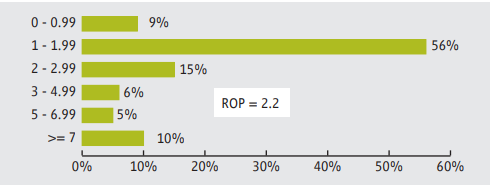
The graph below (Figure 5) shows how the benefits of occupational safety and health were rated. The areas rated by companies as having particular relevance were increases in employee motivation and satisfaction and improvements in company image. The proportional distribution resulted from the relevant types of benefits that were identified in the interviews.
Figure 5. Relevant benefit types
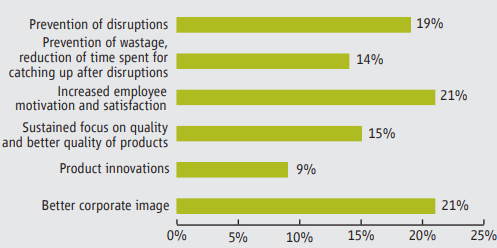
The prevention balance sheet (Table 1) compares the costs of prevention with the (monetary) benefits of prevention. The bottom line shows prevention success. The monetary value of the benefits can only be calculated indirectly. In the first stage, the overall monetary benefit as a product of the overall costs and return on prevention (ROP) is determined. Then a percentage distribution of the overall benefit is applied to the individual types of benefits according to their relevance (see Figure 5).
An additional multivariate analysis revealed correlations, including the following significant findings:
• Companies in Asia tended to rate the impact and effects of occupational safety and health in the workplace and on the company higher than companies in Europe and North America. This also applies to how they rated practising occupational safety and health.
• Larger companies tended to rate the impact and effects of occupational safety and health in the workplace and on the company higher than smaller companies.
Table 1. Prevention costs and benefits for companies
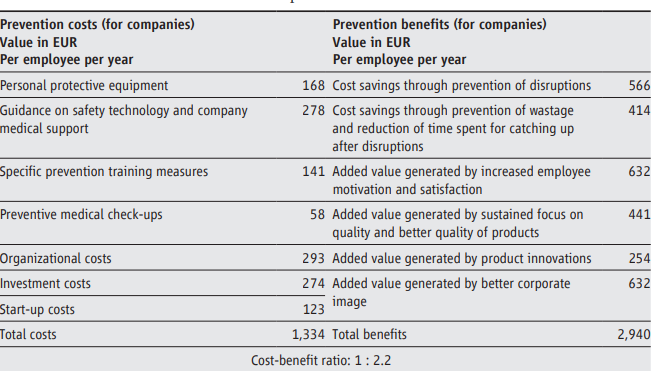
• There was a positive correlation between how the impact and effects of occupational safety and health in the workplace and on the company were rated and the efficiency of the labour market.
• Companies in Asia tended to report increasing or decreasing company costs associated with additional investment in occupational safety and health, whereas companies in Europe and North America reported that costs would remain the same or decrease.
IV.Key conclusions
Prevention accounting seeks to calculate based on interviews and estimations whether the effort required to ensure occupational safety and health offers a meaningful level of return in the microeconomic terms (Return on Prevention).
The study finds that there are benefits resulting from investment in occupational safety and health in microeconomic terms, with the results offering a Return on Prevention ratio of 2.2. In practice, this means that for every 1 EUR (or any other currency) per employee per year invested by companies in workplace prevention, companies can expect a potential economic return of 2.20 EUR (or any other currency).
Stuck in Completing this Assignment and feeling stressed ? Take our Private Writing Services
The study’s results therefore support the microeconomic case for companies to invest in prevention.
Occupational safety and health is a statutory obligation for employers that is beneficial to employees, but it is equally a factor for business success. On the evidence of this study’s findings, and given the heightened global attention being given to issues of occupational safety and health, this message deserves to be promoted more vigorously at the national and international level.
